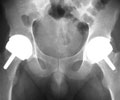 |
The natural hip is a ball and socket joint. The head of the femur (thighbone) moves in a socket in the pelvis called the acetabulum. The joint is held together by tendons, ligaments and muscles. When the hip joint wears out it is called osteoarthritis. An osteoarthritic hip is usually stiff and painful. One possible treatment is the replacement |
In hip resurfacing, the hip joint is relined rather than replaced. The head and neck of the femur are preserved. The worn surfaces of the head and socket are carefully machined away with precision instruments. The joint is then lined with a metal covering for the head and socket. The hip resurfacing implant has three key advantages: as follows
Bone Conservation
| One of the major problems of revision hip surgery (where a worn out or loose hip implant has to be changed to another one) is the loss of bone which necessitates the use of larger and longer hip stems. In hip resurfacing the head and neck are preserved. The worn surface and only 3-4 mm of bone below it are removed. This allows the patients to keep as much of their own hip as possible for as long as possible. Therefore if the resurfacing should fail for any reason the head and neck can be removed and a standard total hip replacement can be performed. |
 |
Low Wear Bearing
One of the major advantages of hip resurfacing is the metal-on-metal bearing. The precision-engineered components are made of a hard, biocompatible alloy (which consists mainly of cobalt and chromium) which produces very low rates of wear. The bearing used in Durom Hip Resurfacing is known as Metasul® Metal-on-Metal Tribological Solution. The Metasul bearing has been in clinical use since 1988 and over 250,000 hips with these bearings have been implanted worldwide. This particular bearing is used solely as an example. Please contact your doctor for your specific bearing used.Anatomic Sized Bearing
In a resurfaced hip the femoral head is similar in size to the natural hip. In conventional total hip replacement the average head size is smaller than the natural hip. The advantage of a larger head size is a greater range of movement of the hip and increased stability, in other words less chance of it coming out of joint (dislocating).
